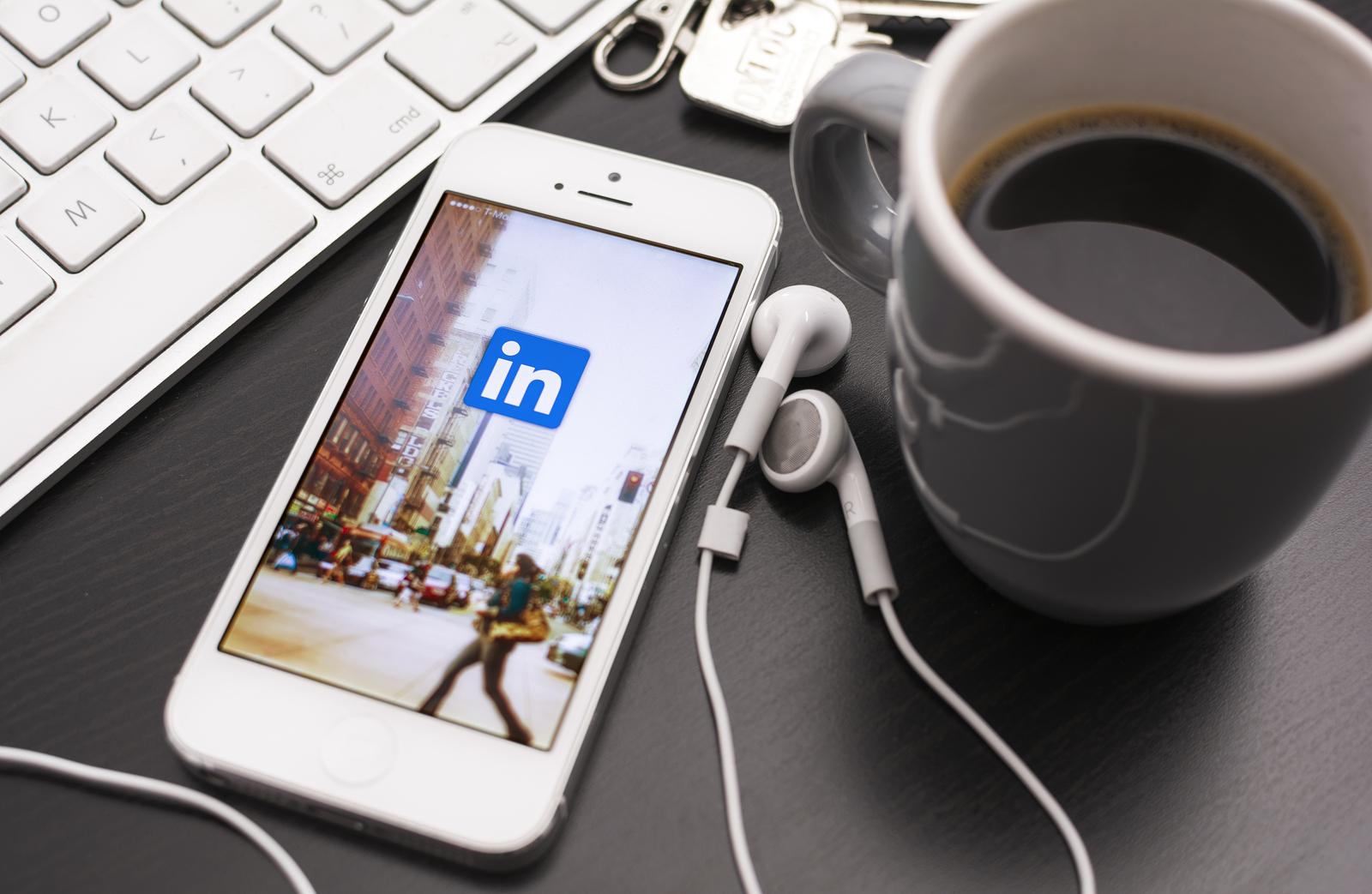As a B2B company, you know getting leads is a crucial part of driving sales.
While as a B2C company you can afford to have a very generic-based approach, with B2B, your clients will be very niche-specific.
Mostly these will be people with their own business. To target these types of people, one of the best places to go to is LinkedIn.
With any type of targeting, you should have a solid plan with you to back you up. Generating leads from LinkedIn is a multifaceted approach where you may need to take care of multiple things.
Here are some ways you can generate free B2B leads from LinkedIn.
Creating Your Profile
LinkedIn was made to connect with people professionally specifically. Be it to connect with people from the same industry as yours or people from other industries, LinkedIn is designed for both.
In the end, however, it is just like any other social media website. People will judge you based on your profile. While missing that Follow request or Friend request from that person on Instagram or Facebook is okay, when it comes to LinkedIn, it can be translated to missed business opportunities.
Your profile is one of the most important elements that can help you get leads on the platform. When you send a request to anybody on the platform, they will see a notification that will display your profile photo, your title, and your message.
LinkedIn is a very professional platform—meaning, there are some unofficial standards you have to adhere to. The basics of which are getting a good profile picture and writing a great profile summary.
Getting a Good Profile Picture
Your display photo should look clean and professional, so don’t mind spending that extra bucks on getting a good photographer. A good photo can lead to a good business deal in the future.
Writing Your Profile Summary
When other people get invites from you, they usually follow a funnel. They will first see whether you seem professional or not judging by your photo. They will then go through your summary, and if still interested, they will check out your entire profile.
It is only fair to assume that a person who has reached the bottom of the funnel is more likely to accept your request and start having a conversation with you.
Let’s focus on the second part: writing the summary.
There are some basic tips when it comes to writing a summary:
- Keep the language simple.
- Write in the first person.
- Keep the tone friendly and approachable (and also professional at the same time).
- Keep the target audience in your mind (which department you want to target people in sales, management, tech).
- Include your achievements in the bio.
While this is not a sure-shot way of getting people’s attention, it is a nice primer that includes all the elements which increase the chances.
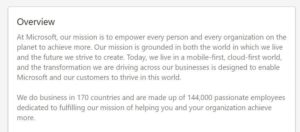
You can see how Microsoft, in its summary has covered its objective in a well-defined manner. Notice how it has also included another paragraph to show you how it can help you and your organization.
What’s most important here is that you should know what audience you are targeting. Rather than having a generic approach for everybody, it is advisable that you keep your goals narrow and focused on better results.
Talking about your general profile, you can include all the other details like education, experiences, skills, and endorsements, etc.
Title
LinkedIn provides a unique feature called the headline. It is placed alongside your profile picture and your name. Also, conventionally, people write their current job titles and the current company they are associated with.
Here’s one of the ways it works: Suppose you are trying to target CEOs of small- to medium-sized companies. Now, CEOs generally like to talk to people who have some power and influence. So it is better to write in your title: CEO of XYZ company. This will help you to get connections faster.
You can also mix and match words and sentences to get others’ attention.
Creating the profile page is one of the key steps in getting free B2B leads. The LinkedIn profile plays a crucial role in generating B2B leads.
Groups on LinkedIn
Perhaps one of the best places to get free leads on LinkedIn is from groups. There are various groups present on the platform with people having similar interests, skills, and needs.
It helps you in two ways: It helps you to keep up with all the latest happenings in the industry; hence, it can be used as a source to know what the customers want, more so in a B2B setup.
Second, you will have a list of potential clients present in the group. The more people, the better it is. By connecting with other people, you will find someone who will buy your product, or they may know someone else who will.
Overall, the network plays a crucial role in leading sales, and LinkedIn groups help you do so.
Another good part about groups is that it avoids blatant promotion. You want to sell your product, but by simply promoting it on the platform, nobody will buy it. With groups, you can solve queries and engage in different conversations which can help you build credibility.
This credibility can come handy in indirect promotion of you and your products.
Which Groups to Join?
Now that you know the importance of groups, the next thing to know is which groups to join.
There are lots of groups that you can join on LinkedIn, but a solid rule of thumb is to see it from the perspective of your customers. Put yourself in their shoes, and see what queries and requirements they might have.
Now that you have a list of queries, you should seek groups that address exactly those types of queries.
You get to join a maximum of 50 groups, which is more than enough. You can look for groups by simply searching the keywords of the expected queries, and LinkedIn will deliver your queries from posts.
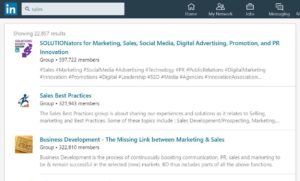
LinkedIn also offers its own Discovery feature, through which it suggests to you groups to join. It selects the groups on the basis of your connections.
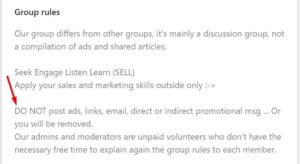
You should look at the description of the group and which people are present. If salespeople dominate the group, you will get spammed now and then. Plus, other crucial factors are demographic and the strength of the group.
If the group offers you the ability to add links (which is rare, unless you provide content that answers the query), then it’s well and good. If it doesn’t, don’t worry, these groups tend to focus more on having good conversations.
These conversations have a higher chance of converting into good relationships and into better sales later.
Making Use of Company Profile
People end up focusing too much on optimizing on their profile that they fail to focus on other sources of getting leads. One of these ways is to make use of the company profile.
Apart from your profile, brands often make use of their profile pages. Using the brand’s profile, you can interact with other brands and communicate with each other on the platform.
What’s important is the fact that it doesn’t self-promote just to get leads. More important is to build a network that guarantees you more lead on the run. So even if you don’t get to share links about your product, it is okay.
One other use of the company profile is that you can effectively use it for outbound marketing. All the other methods present on the list are inbound marketing centered on the platform.
To implement outbound marketing, you can share your LinkedIn page links on your website and other social media platforms like Facebook and Instagram to connect better and drive more traffic (especially business-oriented people).
Optimizing the Profile
Like your private profile, you should make the company’s profile look professional as well. After all, it is the face of your company; make sure it reflects all your and your company’s best qualities.
Notice how Microsoft crafted the title to their LinkedIn page.
Start with photos. You should upload a picture that accurately describes your brand. People often choose to upload the company’s logo.
You can make use of the Products and Services tab. Here you can upload links, descriptions of the products/services you offer, etc.
Then comes the summary. The summary is preferably kept concise, focusing on what you have to offer and what you seek from other people. You can add the company’s achievements to the mix to increase its appeal.
Other Ways You Can Make Use of LinkedIn
- Create blog posts. You can write general posts that help your readers or informative posts related to your product.
- Ask your company’s employees to add your company to their profile description. This will allow people they interact with to check out about your company.
- Make use of Slideshare. Slideshare is a presentation-sharing website that has been bought by LinkedIn. You can make use of Slideshare to better promote your product on your company’s profile page.
Another way you can leverage LinkedIn is through testimonials. Ask your LinkedIn followers to leave a testimonial about your product or service. You can further use these testimonials on your website as well.
Content Marketing
People focus so much on building connections that they often tend to forget that LinkedIn can be also used to share content.
No matter which platform you choose to get leads, the content will always be an important factor. Content acts as a great banking platform; you can show others that you want to contribute to the platform and help their queries. Make sure that content is SEO optimized if you want to generate organic visitors. Because in the end, users will look for what they are gaining from you.
You can start by sharing your own articles, or it can be others as well. The main point is, it should address some problems and offer a solution. On your part, you can search in the groups about the usual problems people face, do your research, and write high-quality posts about them.
For example, here’s how Neil Patel uses LinkedIn as a platform to share his articles.
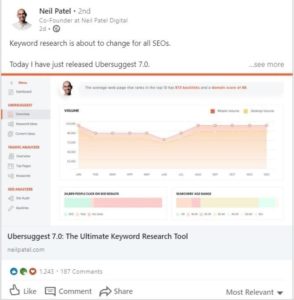
You can also make use of LinkedIn’s Pulse, their own content aggregation tool to share self-published content with their audience.
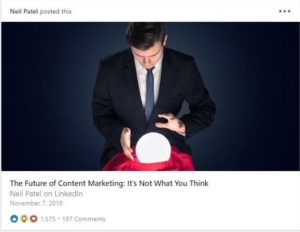
Effective Storytelling
As we talked before, LinkedIn can be a great platform for people who want to solve their doubts. While text-based content is no doubt a good option if you can do it in the form of videos, the better it would be for your business.
Videos can be used effectively to connect with others. You must have seen lately a sudden spike in people creating bite-sized videos for Facebook. You can use the same technique to post storytelling videos on LinkedIn.
People want to know the solutions. They would feel more comfortable when they know they are not alone in facing a certain problem and there are people who have succeeded in solving it. Here’s one of the examples:
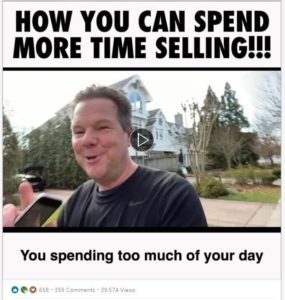
These types of posts usually get high engagements, as you can see with the views and comments. The more LinkedIn sees your article as engaging, the more it suggests to other people.
Make sure you first do the keyword research into the trending queries. There should be a context and a solid background of what you are talking about. Otherwise, people will get confused, and the engagement rate will drop significantly.
Keeping Up with New Connections
Getting new connections is only a part of the equation. Another important aspect is that you should keep up with them. Regularly talk and engage with them.
It’s important to note that you shouldn’t proceed to talk with them just for the sake of getting a sale out of them. With new connections, you should focus more on building strong relationships. Ask them queries, ask their queries, share relevant articles and infographics, and so on.
Once you build a good relationship, you can perhaps schedule an official appointment with them for a pitch for your product!
Or else you can leverage good connections to further help you get more connections. It is a win-win situation provided you invest your time and effort properly.
Likes to Leads
We talked about two important things when it comes to content: it can be either text-based or in video form.
The common aim of both mediums should be to get more engagement, through comments, likes, and shares.
Although these metrics can give you a brief idea about how well your shared content is doing on the platform, you won’t know whether those people are checking out your profile and your information.
Through the list of people who have liked the post, you can get a pool of individuals who may share some aspirations and interests like you. You can then vet among the list of people and try to connect with them individually.
Make Use of Lead Magnet
The first time people come across your brand, only a small percentage would actually be involved in direct sales.
People often need to be persuaded about why your product is good and why it can solve their problems. This mailing list can often come in handy. You can keep a list of people who are interested in the content you are offering and may be interested to check your products.
By making use of this, you can make sure of the group of people you can target. Not only that, but you can promote your other content and future product releases.
Make sure that you are offering some solid content that helps them. Since you are asking them for their e-mail addresses, you have to offer content that makes them feel that your offering will help them in some significant way.
Conclusion
LinkedIn, if leveraged properly, can give you fruitful leads. Be it B2B or B2C, LinkedIn can help you get involved in business-oriented people, who can be your potential customers.
Especially for B2B, LinkedIn should be a part of your plan when it comes to getting leads. Thus, we talked about some of the essential and free ways you can use to get B2B leads on the platform.

